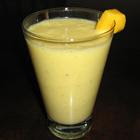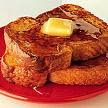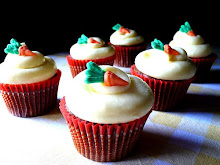Friday, September 26, 2008
FOODS THAT FIGHT AFTERNOON SLUMPS
Posted by Dolkar at 3:21 PM 0 comments
Thursday, September 25, 2008
WHAT YOUR MOUTH SAYS ABOUT YOUR HEALTH
A way to keep your gums healthy: YOGURT (containing live cultures) or a good Probiotic! Flossing and brushing your teeth daily can make your general health as well as make you look much younger.
- Real Age June, 2008
Posted by Dolkar at 3:40 PM 0 comments
Wednesday, September 24, 2008
THE BEST KIND OF STALKER
Posted by Dolkar at 8:06 PM 0 comments
Monday, September 22, 2008
DELICIOUS ZUCCHINI PANCAKES
4 tablespoons raw cane sugar
1 tablespoon baking powder
3/4 teaspoon salt
1 1/4 cups milk, rice milk or soy milk
3 eggs, beaten
3 tablespoons canola or olive oil
1 cup shredded zucchini
1. Whisk flour, sugar, baking powder and salt in large bowl. Whisk milk, eggs and oil in large bowl. Stir in zucchini until well-blended. Stir into flour mixture until ingredients are moistened.
2. Heat griddle to 325°F. (or large skillet over medium heat, adjusting heat as necessary); lightly oil. Spoon batter onto griddle; spread to 4-inch circles. Cook 8 minutes or until golden brown, turning once.
Makes 16 pancakes
PER PANCAKE: 95 calories, 4.5 g total fat (1 g saturated fat), 3 g protein, 11.5 g carbohydrate, 40 mg cholesterol, 225 mg sodium, 1 g fiber
Posted by Dolkar at 12:43 PM 0 comments
Thursday, September 18, 2008
BREAKING NEWS ON CANCER TREATMENT
CANCER IS TRULY ON ITS LAST LEGS!!!
Japanese researchers have uncovered a remarkable new way to boost your immune system's ability to kill cancer cells, viruses, and pathogenic bacteria by up to 300%. This is breaking news, and you're one of the first to hear about it, right here...
Cancer rates in the U.S. are officially “off the charts.” A century ago the disease occurred in 1-in-100 people. Today, half of all adults will get some form of cancer in their lifetime. That’s 1-in-2 people!
Why this alarming increase? It’s being caused by a steady and widespread breakdown of the immune system among our population. Cancer cells, you see, are naturally present in everyone’s bloodstream, but are kept in check by a special immune cell called NK (short for “natural killer”). When NK activity weakens—either from old age, poor nutrition, or stress—cancer cells are free to multiply and become tumors. That’s what’s happening throughout our country today.
Visit our website at http://www.dolkarwellness.com/ for the full length article and many details.
Posted by Dolkar at 11:52 AM 0 comments
Wednesday, September 17, 2008
3 WAYS TO SLEEP BETTER TONIGHT
Are you ready for more restful sleep? Here are four quick and easy activities you can try tonight to help set yourself up for better sleep:
Posted by Dolkar at 8:41 PM 0 comments
Tuesday, September 16, 2008
22 Ways to Tackle Life's Biggest Energy Zappers.
Every day, 2.2 million Americans complain of being tired. Most of us chalk it up to having too much to do and not enough time to do it in, especially during extra-busy periods. But often the true culprits are our everyday habits: what we eat, how we sleep, and how we cope emotionally. Read on for some simple, recharging changes that can help you tackle all of the energy stealers in your life.
Energize Your Diet
Why is it that filling up on pasta or Chinese food for lunch leaves us snacky and sleepy an hour later? Or that falling short on fluids makes us forgetful and foggy? Fact is, eating habits play a powerful role in how well we function on every level. Below, six top fatigue-fighting nutrition strategies to chew on.
Have breakfast... even if you don't feel hungry. You'll be a lot perkier: Studies show that people who eat breakfast feel better both mentally and physically than those who skip their morning meal. British researchers at Cardiff University even found that spooning up a bowl of breakfast cereal every morning is associated with lower levels of the stress hormone cortisol.
Eat every three to four hours. Having three smallish meals and two snacks throughout the day can keep your blood sugar and energy levels stable all day long, says Roberta Anding, R.D., a spokesperson for the American Dietetic Association (ADA). Note the word "smallish." Supersized meals demand more of your energy to digest, which can leave you feeling lethargic. At each mini-meal, get a mix of carbohydrates (which the body uses for energy), protein (which helps sustain energy if needed), and healthy fats like those found in fish, nuts, and olives -- these fats and protein contribute to meal satisfaction, so you don't go hunting for sweets an hour later and wind up with a short-lived sugar high and subsequent crash. A few meal ideas: a low-fat yogurt parfait with berries and a couple of tablespoons of whole-grain granola; salmon over mixed greens with whole-grain crackers; and beef tenderloin with a baked sweet potato and asparagus.
Fill up on more fiber. Fiber has a time-releasing effect on carbs, so they enter your bloodstream at a slow and steady pace, giving your energy staying power, says Anding. When choosing your mini-meals (see above), include fiber-filled options that add up to the daily recommended 25 to 30 grams of fiber (the average person gets only between 10 and 15 grams). Some suggestions: a bowl of raisin bran (5 grams of fiber per cup); black beans and cheese wrapped in a multigrain tortilla (beans have 7.5 grams per 1/2 cup; one tortilla has 5 grams); air-popped popcorn (3.6 grams per 3 cups); an apple with the skin (3.3 grams); and whole-wheat spaghetti (6.3 grams per cup).
Fuel your brain with omega-3s. Found in fatty fish (such as tuna and salmon), walnuts, and canola oil, these essential fatty acids play a role in keeping brain cells healthy and helping you feel mentally alert. Another potential bonus: Omega-3s encourage the body to store carbs as glycogen the storage form of glucose (blood sugar) and the body's main source of stored fuel rather than as fat.
Stay hydrated. Water makes up the majority of your blood and other body fluids, and even mild dehydration can cause blood to thicken, forcing the heart to pump harder to carry blood to your cells and organs and resulting in fatigue. Also, ample fluids keep energy-fueling nutrients flowing throughout the body, says Nancy Clark, R.D., author of Nancy Clark's Sports Nutrition Guidebook. To gauge your hydration, Clark recommends monitoring how often you urinate. You should be going every two to four hours, and your urine should be clear or pale yellow in color. Tip: Besides drinking more, you can also consume foods that naturally contain water, such as yogurt, broccoli, carrots, and juicy fruits, like watermelons, oranges, and grapefruits.
Watch caffeine intake after noon. Typically, consuming a moderate amount of caffeine 200 to 300 mg, the amount found in two to three cups of coffee can make you more energetic and alert in the hours following, says Anthony L. Komaroff, M.D., a professor of medicine at Harvard Medical School. But when caffeine is consumed in large quantities or anytime in the afternoon or evening the quality of your sleep that night can take a nosedive, leaving you with heavy eyelids the next day. One caution for those who are highly sensitive to caffeine: Although switching to a decaf latte in the afternoon sounds like the answer, researchers at the University of Florida found that out of 22 decaffeinated coffee beverages tested, all but one contained some caffeine.
Energize Your Spirit
We're all familiar with physical exhaustion, but mental strain sadness, boredom, worry, anger, and general stress (the biggie) can take an even heavier toll on vitality, completely wearing you out. Life happens, and these difficult emotions will, too. But if you react wisely, your brain and body will rebound along with your vim and vigor.
Splash some water on your face or take a shower when you're feeling burned-out. Some 55 percent of study participants reported using these types of "water therapy" to successfully increase their energy, according to findings in the Journal of Personality and Social Psychology. Apparently, a little H 2 O refresher can instantly help take the edge off when you're feeling overwhelmed.
Suit up in a "power" outfit to beat the blahs. Fight the tendency to throw on sweats when you're feeling sluggish. Although it may seem counterintuitive to slip into the skirt you save for special occasions, it helps to look in the mirror and see an energizing image not a deflating one that confirms and reinforces your internal state, says Alice D. Domar, Ph.D., founder and executive director of the Domar Center for Complementary Healthcare in Waltham, MA. Dressing for success will give you a big mental boost every time you catch sight of your reflection (or receive a compliment) throughout the day.
Turn on some tunes. Listening to music is one of the most effective ways to change a bad mood, decrease tension, and increase energy. Consider this: Runners in one study who listened to music while on the treadmill ran faster than those who jogged in silence no matter how loud the volume or how fast the tempo, according to new findings in the journal Ergonomics. Other research suggests that music effectively distracts you from feeling fatigue. Try burning a CD of your favorite songs and playing it anytime you need a pick-me-up. (If you exercise, so much the better but the music will move you either way.)
Let go of grudges. Nursing a grudge prompts your mind and body to react as if they're under chronic stress, increasing your heart rate and blood pressure and potentially resulting in an impaired immune system and exhaustion over time, according to a study in the journal Psychological Science. On the other hand, practicing empathy and forgiveness after you've been wronged makes you feel as if you're back in control, which keeps the body's stress responses in check. The next time you find yourself harboring ill feelings, repeat a stress-relieving mantra to yourself, such as, "Forgiveness makes me a happier and stronger person."
Take belly breaths. When we're under stress, we're prone to take "chest breaths" short, shallow ones, says Domar. Chest breathing brings less air into the lungs and reduces the supply of energizing oxygen to the body and brain, leaving you physically and mentally drained. The goal is deep, diaphragmatic breathing like that of a sleeping infant: When you breathe in, your belly should round and fill like a balloon; on an exhale, your belly should slowly deflate. Of course, remembering to practice deep breathing isn't the first thing on your mind when you're under the gun, so as a visual reminder, try posting a tranquil picture (such as a pool of water or your kids smiling) with the word "breathe" next to your computer, or anywhere you tend to feel on edge.
De-clutter a corner. Go through that teetering pile of papers or overflowing closet and clear it out. Clutter can make you feel out of control and overwhelmed, especially when you're already feeling stressed or down. Plus, simply accomplishing a goal, no matter how seemingly minor, can be energizing, says Domar.
Do some good. Acts of altruism can lend a little pep to your step. In fact, one study in the Journal of Health and Social Behavior found that volunteer work can boost your energy in six ways: It enhances happiness, life satisfaction, self-esteem, sense of control over life, physical health, and mood. Find short- and long-term volunteer opportunities at www.abetterchancefo undation. org.ph
Get a Restorative Rest
When you have a lot to do (um...always) , usually the first thing to get squeezed off your agenda is sleep. But miss out on shut-eye and your energy, positivity, productivity, and memory are sure to suffer. And nearly a quarter of American adults aren't getting enough rest, which has led to an epidemic of daytime sleepiness, according to a poll by the National Sleep Foundation. The key to bucking this trend is to brush up on sleep hygiene. Try these steps for starters.
Cut back on TV and computer time after 8 p.m. If you're already a night owl (you go to bed late and sleep in on weekends), the bright light emitted from television and computer screens can make falling asleep at a decent hour even harder. The reason: Light suppresses the production of melatonin, a hormone secreted at sunset that tells the brain that it's nighttime, explains John Herman, Ph.D., director of the training program in sleep medicine at the University of Texas Southwestern Medical School at Dallas. And when melatonin levels are low, your brain is fooled into thinking that it's still daytime and remains raring to go. Whenever possible, wait until the next morning to tune in and/or log on. If you must use light-emitting technology at night, try to turn it off an hour or two before hitting the sack.
Hide your alarm clock. Watching the clock to see how long it's taking you to drift off or how much time you have left before your alarm goes off can result in a poor night's sleep, says Kelly A. Carden, M.D., medical director of the Sleep Health Center Affiliated with Hallmark Health at Medford in Medford, MA. This hypervigilance keeps the brain awake and alert and prevents you from slipping into deep, restorative sleep. The easy fix: Set your alarm clock, then either face the numbers away from you or put it on the floor, in a drawer, or across the room.
Give your pet his own separate sleeping space. At night, pets snore, jiggle their tags, move around a lot, and even hog the covers and bed space. It's no wonder that 53 percent of pet owners who sleep with their pets in the bedroom have some type of disrupted sleep every night, according to a study from the Mayo Clinic Sleep Disorders Center in Rochester, MN. Consider relocating your furry friend's sleeping quarters to another area, even if it's just his own bed in your bedroom.
Lower the thermostat. For a good night's sleep, make sure your room is comfortably cool enough so that you need a light blanket. This ensures that your environment is in sync with your body's internal temperature, which naturally drops during the night, according to the National Sleep Foundation. Studies suggest the ideal sleeping temperature is between 54 and 75 degrees; anything cooler or warmer may cause you to wake up.
Skip the nightcap. Alcohol depresses the nervous system the system of cells, tissues, nerves, and organs that controls the body's responses to internal and external stimuli. So while sipping a glass of wine before bed may help you nod off, the sedative effects wear off as your body metabolizes the alcohol, which may cause you to wake up in the middle of the night and have trouble falling back to sleep. Alcohol has also been shown to interfere with the body's natural 24-hour biorhythms, causing blood pressure to rise and heart rate to race at night when it's normally calm and relaxed. You don't have to give up that evening cocktail entirely to achieve sound sleep just try to avoid alcohol within two to three hours of bedtime.
Get your exercise. While scientists don't yet understand why, aerobic exercise has been proved to help you fall asleep faster at bedtime, spend more hours in deep sleep, and wake up less often throughout the night, says Komaroff. At the same time, vigorous exercise can act like a stimulant (which is a great daytime energizer), so schedule your workouts in the morning or afternoon, when you need a boost the most
Follow the 15-minute rule. If you can't fall asleep, or if you wake up and can't get back to sleep within about 15 minutes, get out of bed and do something relaxing that will help clear your head, such as reading, meditating, or knitting (but not watching TV or surfing the Web). Then, once you feel sleepy again, go back to bed. If you stay put and fret about being awake, you'll only make yourself more anxious and less likely to catch the z's you need.
Write down your worries. During the day, jot down any stressors that are weighing on you, says Carden. Then, do some mental problem-solving before your head hits the pillow or, if you're falling short on solutions, tuck your list away and resolve to brainstorm ideas during your morning shower or commute to work. Just knowing you've established a plan for tackling your to-do's will make you feel like you've made some progress, allowing you to relax, drift off and wake up the next morning ready to take on the day. Dolkar Wellness can help.
Author: Unknown
Posted by Dolkar at 1:34 PM 1 comments
Friday, September 12, 2008
LOVE YOUR LIVER
The primary way your body cleanses itself of toxins is through your liver – it keeps poisons out of your bloodstream. Minimizing the poisons that have to be filtered out is essential for blood purification and liver damage prevention.
Fortunately, the outermost layer covering your entire body helps your liver eliminate toxins. The skin is an important detoxification ally and, thus, its ability to breathe can support the monster job of removing unwanted poisons.
The inflammatory state of a liver with chronic liver disease can be perceived as a bin full of smoldering coals, where everyday choices either keep those coals cool or spark a raging fire. Liver health advocates place a great deal of emphasis on avoiding food or drink that, when taken internally, contribute to liver inflammation. However, many people don’t realize that substances placed externally on the skin also impact the liver’s coals.
If the liver is inflamed or damaged, toxins remain to circulate throughout the body. When functioning optimally, the skin can actually help or hinder the liver’s detoxification process. The skin and liver detoxification relationship has two facets:
1. the skin can absorb poisonous chemicals, increasing the liver’s detoxification load
2. the skin can expel toxins, relieving the liver’s detoxification load
Unfortunately, people regularly slather their skin with a coating that prevents toxin elimination through the pores – a surefire way to contain poisons earmarked for elimination. With this exit blocked, more toxins remain in the body’s circulation to fan the flames of hepatic inflammation.
The skin is the elimination organ with the largest surface area. In addition to regulating temperature and body moisture content, the skin also functions as a backup or waste removal. If the liver is unable to process toxins, the skin provides an alternate escape route. However, the pores must be open and clear for this process to occur without event. Skin rashes, acne or other skin disorders are often indicators of a toxic build-up beneath the skin’s surface caused by clogged pores.
Common Clogging Culprit
Also known in the fossil fuel industry as crude oil, most of us come into contact with petroleum every day. Products containing petroleum include gasoline, Styrofoam, lubricating oils and many cosmetics. Claiming to moisturize our hair, skin and lips, mineral oil and petroleum are the primary ingredients in many beauty products. By covering the skin to form a protective barrier, petroleum and mineral oil effectively lock moisture against the skin.
Unfortunately, this supposedly beneficial barrier blocks more than is desired. Because it prevents the skin from breathing and expelling toxins, petroleum-based products can obstruct the skin from eliminating waste, thus increasing the liver’s detoxification load. Check the ingredients on your skin care products to see if any of these petroleum derivatives are present:
· Mineral Oil
· Petroleum or Petrolatum
· Propylene Glycol
· Isopropyl Alcohol
· Ceresin
· Toluene
· Benzene
· Paraffin
If you find these ingredients lurking in your home, consider replacing them with products that support your skin’s elimination function. For a person living with chronic liver disease, passing on petroleum may not only improve a dermatological condition, but it may also help your liver’s coals stay cool.
Dolkar Wellness
References:
Hampton, Aubrey. “Ten Synthetic Cosmetic Ingredients to Avoid.” Organic Consumers Association. June 28, 2008
http://en.allexperts.com/q/Herbs-Health-3224/Detox.htm, Herbs for Health, Dennis
Posted by Dolkar at 2:03 PM 0 comments
Sunday, September 7, 2008
HEALTH BENEFITS OF NIACINAMIDE
The therapeutic effects of niacinamide were first studied in the mid-to-late 1930s by Dr. William Kaufman. Research at the time revealed that niacinamide was necessary for the formation of two coenzymes. These coenzymes are crucial to over 200 metabolic processes in the human body, including energy production.
As he continued his research, Dr. Kaufman discovered that inadequate amounts of niacinamide in the diet could be directly responsible for a long list of physical and mental problems—ones that were simply considered a “normal” part of the aging process. His
list included such varied conditions as nervous system impairment (resulting in depression, anxiety, and personality changes), over-reaction to noise, abnormal skin sensations, changes in mucous membranes, excessive callus formation, and yellowish or brown pigmentation of the skin.
The therapeutic benefits of niacinamide for joint pain are now well known. Taking 1,500 mg daily in 250 mg doses spaced throughout the day can provide relief for even the most extreme examples of the problems I listed. (Taking the 1,500 mg all at once won’t give you the same results, however. You need to keep taking it throughout the day to keep the level in your blood fairly stable.) Here are a couple of other ways you can take advantage of niacinamide’s benefits - http://dolkarwellness.com/articleniacinamide.
Posted by Dolkar at 4:45 PM 0 comments




















